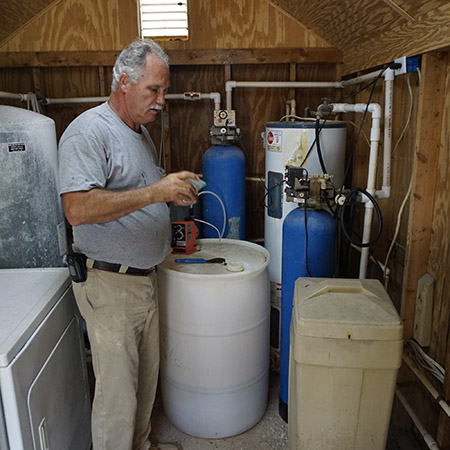Common Water Contaminants and their Potential Risks
 Stories about dangerously contaminated water frequently make the news. These stories have brought attention to the hazards that could be hiding in your water and the risks posed by the United States’ aging infrastructure. Researchers have exposed the fact that bottled water can be equally unsafe. How can you know if the water you’re drinking is safe?
Stories about dangerously contaminated water frequently make the news. These stories have brought attention to the hazards that could be hiding in your water and the risks posed by the United States’ aging infrastructure. Researchers have exposed the fact that bottled water can be equally unsafe. How can you know if the water you’re drinking is safe?
The first step is to arm yourself with information about common water contaminants and their potential risks. As Schoolhouse Rock taught us, “knowledge is power!” Armed with this information, you’ll be able to interpret water quality results and know if you should take action.
Potential Water Contaminants
Water can be contaminated by human activities or naturally occurring sources.
Microorganisms
Bacteria, viruses, and parasites are all harmful microorganisms that can be found in water. The most common bacteria found in water are E. coli and legionella. The most common parasitic pathogens in water are Cryptosporidium and Giardia. There are a wide range of viruses that can enter water sources including hepatitis A and E, rotavirus, and norovirus. These naturally occurring contaminants are often found in untreated water. The health impact of drinking water that’s contaminated with microorganisms varies dramatically depending on what you’ve consumed. It can range from gastrointestinal discomfort to serious infections.
Organic Chemicals
Unlike organic foods, organic chemicals can be harmful. Organic chemicals are used to make many household products such as disinfectants, dyes, inks, herbicides and pesticides, paints, pharmaceuticals, and petroleum products. These chemicals can seep into groundwater and enter bodies of water due to waste disposal leakage, spills, and water run-off. Consuming water with high levels of organic chemicals can damage your circulatory system, kidneys, liver, nervous system or reproductive system.
Heavy Metals
Lead, copper, and arsenic are just a few of the heavy metals that can find their way into drinking water. While heavy metals can be naturally present in soil, dangerously high concentrations in water are usually the result of human activity or corroded plumbing. Electronics manufacturers, petroleum refineries, municipal waste disposal, and cement plants can pollute the surrounding area with heavy metals. Rainwater and irrigation systems carry these heavy metals into bodies of water and local groundwater. Drinking or cooking with water that has high levels of heavy metals can have many serious health impacts. The risks include acute and chronic toxicity damaging your liver, kidney, and intestines as well as anemia and cancer. The risks for infants and children can be more severe and long-lasting such as development issues and irreversible neurological damage.
Nitrate/Nitrite
Nitrate and nitrite are components of nitric acid that are found in animal waste and fertilizers, chemical fertilizers, and human sewage. Run-off from farms and gardens into groundwater is the primary cause of nitrate/nitrite water contamination. The risks associated with drinking water with nitrate or nitrite is low for children and adults but potentially fatal for infants. If infants under six months old ingest water with high levels of nitrates they can become seriously ill or die. It is so dangerous for infants because nitrate/nitrite reduces blood’s ability to carry oxygen. This restriction of oxygen can cause methemoglobinemia also known as “blue baby syndrome.” It isn’t hazardous for infants older than 6 months old, children and adults because fully developed digestive systems can digest nitrates without this negative side effect.
Radionuclides
Radioactive forms of elements, such as radium and uranium, are known as radionuclides. Human activities such as coal mining, uranium mining and nuclear power production can release radionuclides into the environment. Wastewater seepage and flooding can cause them to enter private wells. Consuming water with radionuclides can increase your risk of cancer or result in a toxic kidney effect.
Fluoride
Many municipalities add fluoride to water because it can prevent tooth decay. Excessive consumption of high levels of fluoride can be harmful. It can lead to a condition known as skeletal fluorosis. Symptoms of skeletal fluorosis are painful and tender bones and joints. Drinking water with excessive amounts of fluoride during your developmental years can cause dental fluorosis, pitting in teeth or tooth decay.
Assessing the Risks of Water Contamination
Since city water in the U.S. is regulated by the EPA’s National Primary Drinking Water Regulations it is less likely to contain most of these contaminants. High concentrations of heavy metals from aging and corroded pipes are the greatest risk. As water travels through pipes to your home, it can pick up heavy metals or bacteria in the pipes. Since these contaminants enter the water outside of the water treatment center, they are less likely to show up in your local water system’s Consumer Confidence Report. The only way to find out if the water coming out of your tap is free of heavy metals and bacteria is to have it tested.
 Wellwater has the highest risk of containing microorganisms, organic chemicals, heavy metals, nitrates/nitrites or radionuclides. Private wells aren’t regulated by the EPA or tested by local authorities. The responsibility for monitoring and treating your water falls entirely on your shoulder. Since drinking unpurified water can expose you to a variety of harmful pathogens and pollutants, it’s important to have your water tested at least once a year. If you’d like more information about the most common risks in your area, check out the U.S. Geologic Survey’s “Ground Water and the Rural Homeowner!”
Wellwater has the highest risk of containing microorganisms, organic chemicals, heavy metals, nitrates/nitrites or radionuclides. Private wells aren’t regulated by the EPA or tested by local authorities. The responsibility for monitoring and treating your water falls entirely on your shoulder. Since drinking unpurified water can expose you to a variety of harmful pathogens and pollutants, it’s important to have your water tested at least once a year. If you’d like more information about the most common risks in your area, check out the U.S. Geologic Survey’s “Ground Water and the Rural Homeowner!”
If you are concerned about your water quality, you can have it tested by a local water quality expert like Tri-Florida Water Treatment. We offer free in-home analysis for residents in the Lakeland, FL area. The best solution to ensure the water you use is safe is a water purification system. Check out our blog How Do What Filters Work to learn more!
